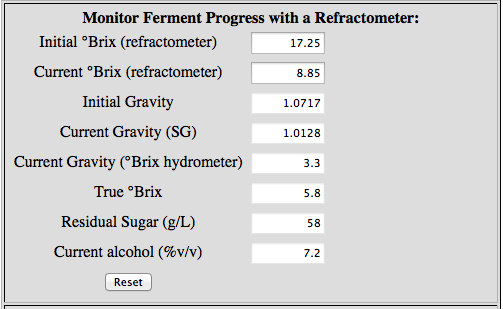Making an all-grain Double IPA, OG of 1.071, and I didn't realize that between brewing and the end of fermentation, my hydrometer developed a hairline crack in the bubble end, allowing enough liquid to get in to make my FG appear lower.
After it completely broke (like the 10th I've gone through) I bought a refractometer. When it arrived, I retested the batch (after I had already cold-crashed it thinking it was 1.010) and it showed a post-fermentation gravity of 1.034, a Brix of about 8.5, give or take.
When I plug that into any of the online converters for post-fermentation refractometer readings, they convert a 17 Brix OG (1.071) and an 8.5 Brix FG to 1.012, which is recipe spot-on.
BUT I bought a new hydrometer and tested the batch last night, and the hydrometer says 1.026.
I don't understand how these two things can peacefully coexist and I'm really looking for some guidance from those more experienced than I. I have to be doing something wrong because I have four batches going right now and none of the conversions seem to jive with the hydrometer readings.
Thanks in advance and cheers.
Single infusion, 152 degrees, mash out to 170
10 lbs Pale Malt (2 Row)
2 lbs 8.0 oz Vienna Malt
1 lbs Oats, Flaked
12.0 oz Cara-Pils
8.0 oz Caramunich
1 lbs Corn Sugar
1.00 oz Columbus (Tomahawk) [14.00 %] - Boil 60
1.00 oz Citra [14.00 %] - Boil 20.0 min
3.00 oz Citra [14.00 %] - Boil 5.0 min
3.00 oz Citra [14.00 %] - Steep/Whirlpool 30.0min California Ale (White Labs #WLP001)
3.00 oz Citra [14.00 %] - Dry Hop 7.0 Days
After it completely broke (like the 10th I've gone through) I bought a refractometer. When it arrived, I retested the batch (after I had already cold-crashed it thinking it was 1.010) and it showed a post-fermentation gravity of 1.034, a Brix of about 8.5, give or take.
When I plug that into any of the online converters for post-fermentation refractometer readings, they convert a 17 Brix OG (1.071) and an 8.5 Brix FG to 1.012, which is recipe spot-on.
BUT I bought a new hydrometer and tested the batch last night, and the hydrometer says 1.026.
I don't understand how these two things can peacefully coexist and I'm really looking for some guidance from those more experienced than I. I have to be doing something wrong because I have four batches going right now and none of the conversions seem to jive with the hydrometer readings.
Thanks in advance and cheers.
Single infusion, 152 degrees, mash out to 170
10 lbs Pale Malt (2 Row)
2 lbs 8.0 oz Vienna Malt
1 lbs Oats, Flaked
12.0 oz Cara-Pils
8.0 oz Caramunich
1 lbs Corn Sugar
1.00 oz Columbus (Tomahawk) [14.00 %] - Boil 60
1.00 oz Citra [14.00 %] - Boil 20.0 min
3.00 oz Citra [14.00 %] - Boil 5.0 min
3.00 oz Citra [14.00 %] - Steep/Whirlpool 30.0min California Ale (White Labs #WLP001)
3.00 oz Citra [14.00 %] - Dry Hop 7.0 Days












































![Craft A Brew - Safale S-04 Dry Yeast - Fermentis - English Ale Dry Yeast - For English and American Ales and Hard Apple Ciders - Ingredients for Home Brewing - Beer Making Supplies - [1 Pack]](https://m.media-amazon.com/images/I/41fVGNh6JfL._SL500_.jpg)












